Jan H Sachers brings history to life
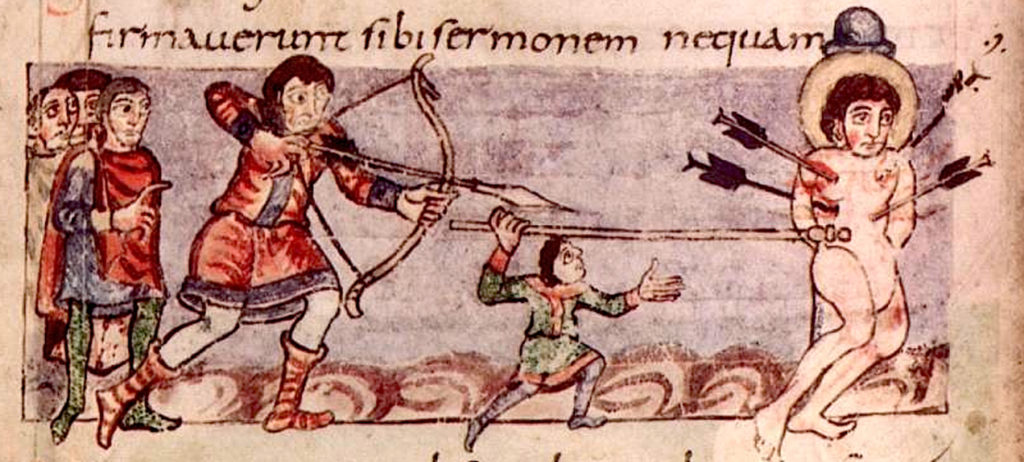
Nydam to Hastings
Bows and arrows were widely used as weapons of war and hunting in the Middle Ages. Considering the massive numbers in which they must have been produced over a period of roughly 1,000 years, they leftvery little archaeological trace.
For one, they were made of perishable natural materials; secondly, unlike swords, armour, or even finely decorated hunting crossbows, they were relatively easily, quickly, and cheaply produced and hence simply discarded when no longer of use.
This is especially true for the millions of arrows whose life span was generally rather short.
The early Middle Ages in particular, from about 500 to 1000 AD, are notoriously lacking in written sources on archery and its materials, and illustrations tend to be schematic rather than detailed depictions.
Nevertheless this article will attempt to sum up our knowledge on early medieval arrows. The part of an arrow most likely to survive the ages is the arrowhead, which was mainly made from iron. Examples are preserved in great enough numbers and variety of shapes to typologise them, analyse their means of manufacture, date them, and sometimes attributethem to specific cultures.
Wooden shafts or fletchings can only be preserved in very special, sealed off conditions. With the spread of Christianity throughout Europe, it also became uncommon to bury the dead with a selection of grave goods, which up to the Carolingian period had often included weapons such as bows and arrows.
Germanic arrows from the Moor
But arms and armour were not only deposited in graves, but also in rivers, lakes, and moors, as ritual offerings to the gods, often rendered useless before.
The most prolific site of this kind discovered so far was a moor near Nydam in today’s Denmark. Its finds are now mostly on display in the museum Schloss Gottorf in Northern Germany.
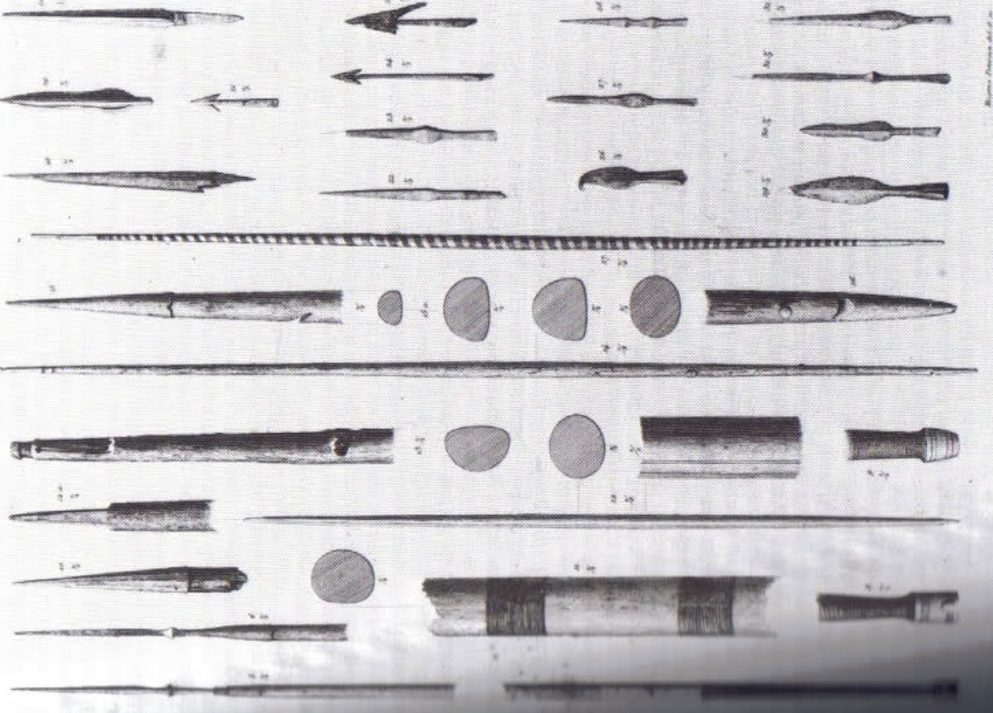
Apart from three entire ships, the objects recovered included some 40 bows or fragments as well as nearly 200 arrows, broken or complete. They are dated to the 3rd to 4th centuries, strictly speaking the late Iron Age, but their shape and manufacture represent a Northern Germanic tradition which carried on well into later centuries.
Shafts were mainly made from pinewood boards, a few from ash. Their length measures an average of 75–80 cm (29.5–31.5 in.). The widest part of 9–12 mm is in the middle, from which the shafts taper towards both ends.
The fletched area is often particularly reduced in girth, so the layer of birch pitch used as glue did not add additional thickness.
By far the majority of arrows were fletched with four feathers of 8–12 cm (3 1/16–4 ¾ in.) length each, which were pulled off the quill rather than split. A very narrow whipping of natural fibres –most likely flax or hemp –secured them in place. Since no feathers have survived, their shapes can only be guessed.
A fletching of four feathers results in additional surface which helps stabilise the arrow in flight, but also slows it down and thus reduces shooting distance.
As a counter measure, the feathers may have been cut very low, but there is no proof for this. The nock ends are always of bulbous shape, to off er enough material for the string groove to be cut in. In some cases, the entire nock is a separate piece of bronze.
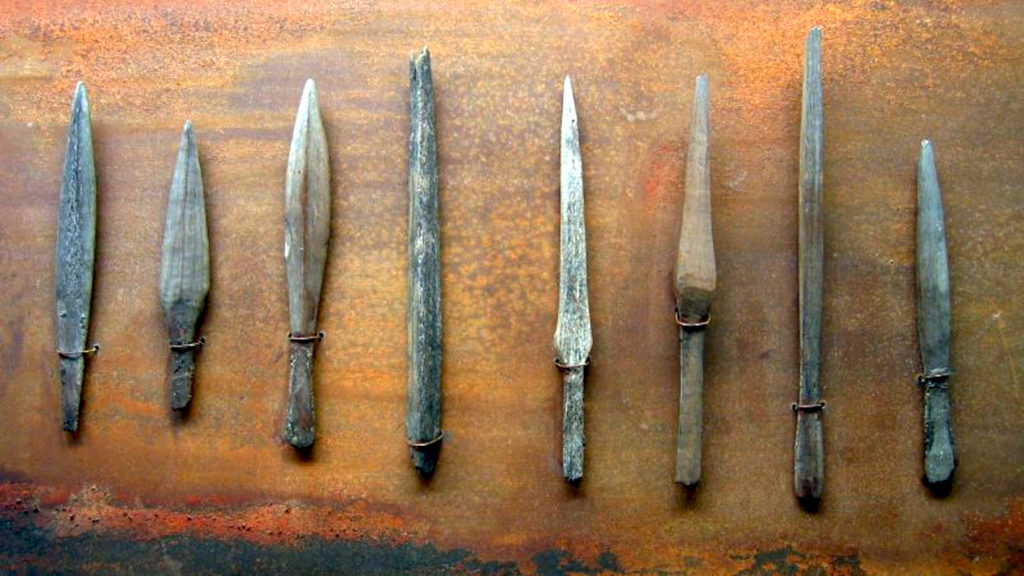
With a few notable exceptions, all the arrowheads were forged from iron, and fall into three categories: (a) flat, triangular, barbed arrowheads, and (b) leaf-shaped bladed heads were both used for hunting and warfare, while (c) long, square or rhomboid bodkins were designed specifically to penetrate chainmail armour and therefore used exclusively in battle.
A small number of arrowheads carved from bone imitate the iron shapes, which in turn resemble the larger spearheads from the same find.
All three types of arrowheads could end in a socket or a tang for insertion into the shaft. They were glued on or in with birch pitch and secured with a wrapping of natural fibres.
Almost identical finds from other sites in Northern Germany and Denmark have been dated to the 3rd to 6th centuries, which gives enough reasons to consider these types of arrows to be the typical design of the Northern Germanic (late) iron age and early medieval times.
Southern Germanic arrows
Another archaeological stroke of luck was the discovery of a vast burial ground in Oberflacht near Tuttlingen on the river Danube in Germany.
Dated to the 6th to 7th centuries, it belonged to the Alamannic culture, which from about 280 AD settled in large parts of Southern Germany, the Alsace, Northern Austria and Switzerland, and Liechtenstein.
Among the finds were a dozen bows and fragments and 18 complete or broken arrows –most of which seem to have disappeared since their first discovery in the 19th century. But according to their early descriptions the complete examples measured only 55–65 cm (21.5–25.5 in.) in length.
This would, however, match the accompanying bows, which due to their long, stiff centre part only allowed for an average draw length of some 24 inches.
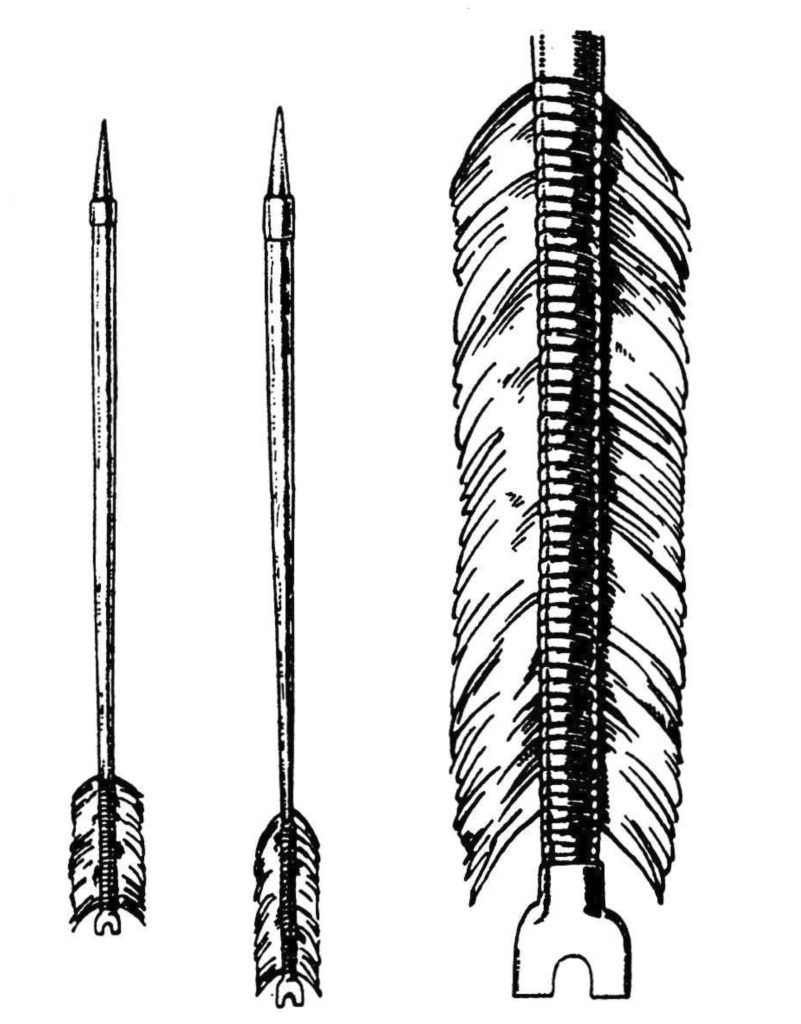
The shafts of birch and at least one other type of wood (possibly viburnum, also known as ’arrow-wood’) measured 9–10 mm at their front end, before tapering to accommodate a conical socket. They evenly tapered from there to the nock end.
No arrowheads were found, but some shafts featured remains of a reddish glue and tiny nails or rivets used to secure them. The rear ends showed traces of three feather fletchings glued on with birch pitch and secured by extremely narrow whipping.
According to the descriptions, the feathers had been glued into straight grooves cut into the wood at even (60°) intervals.
Since there was no string groove cut into the shafts, the nock had probably been a separate piece of wood glued on with birch pitch.
In another Alamannic grave from Altdorf in Switzerland, dated to 660–680 AD, a wooden quiver with leather covering containing remains of eight arrows was found.
The shafts were cut from boards of ash and hazel wood, and honeysuckle saplings. Unfortunately all the rear ends with fletchings and nocks were missing, so one cannot compare them with the finds from Oberflacht.
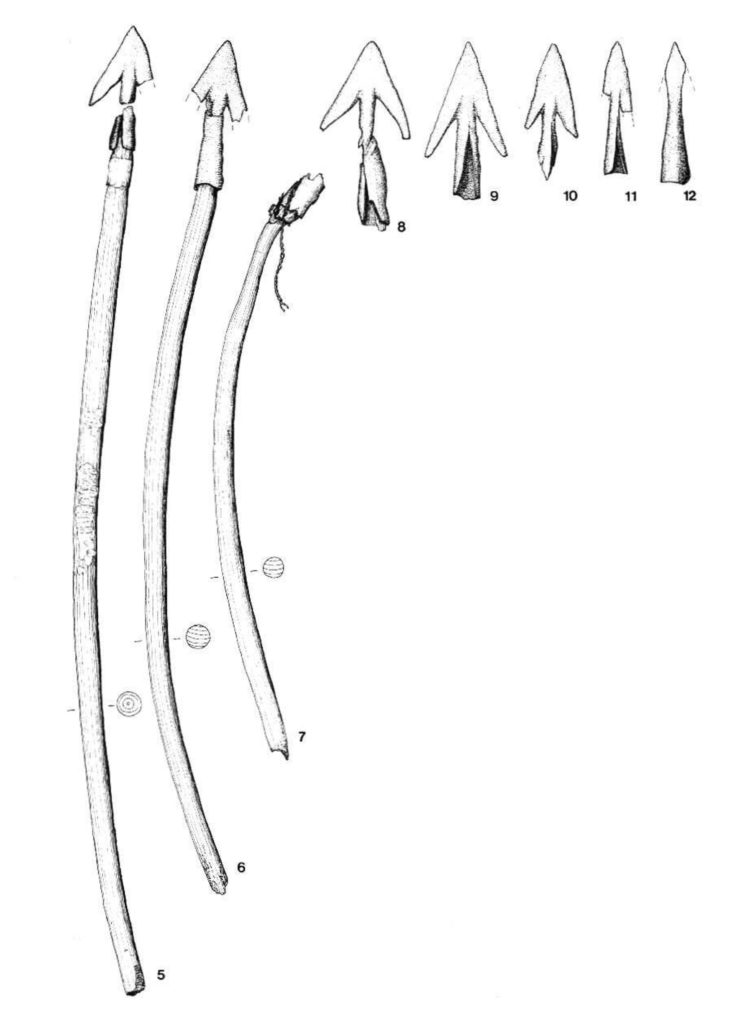
The shaftdiameter was 9–11 mm beneath the conical taper for the arrowhead socket, and one example showed traces of a former binding there. All the iron arrowheads were fl at, triangular, and barbed.
Two-bladed arrowheads in triangular or leaf shape with or without barbs appear to have been the preferred design in the early Middle Ages. Comparatively easy and quickly to make, they could be used for both hunting and warfare, cutting large wounds that bled strongly.
After the end of the migration period, Central and Western European arrowheads seem to have been fixed exclusively onto the shafts with sockets. This was a lot easier than using a tang, for which the wooden shafts had to be drilled, tapered, and bound, but sockets were more difficult to forge, for which an open die and a mandrel would be needed.
Two-bladed, triangular arrowheads with barbs are also very easy to draw –which is probably a reason why they also appear in great numbers in book illustrations of the Carolingian and Ottonian period (c. 800–1024 AD), mostly in stylised form and exaggerated size. But rhomboid blade-heads can also be found.
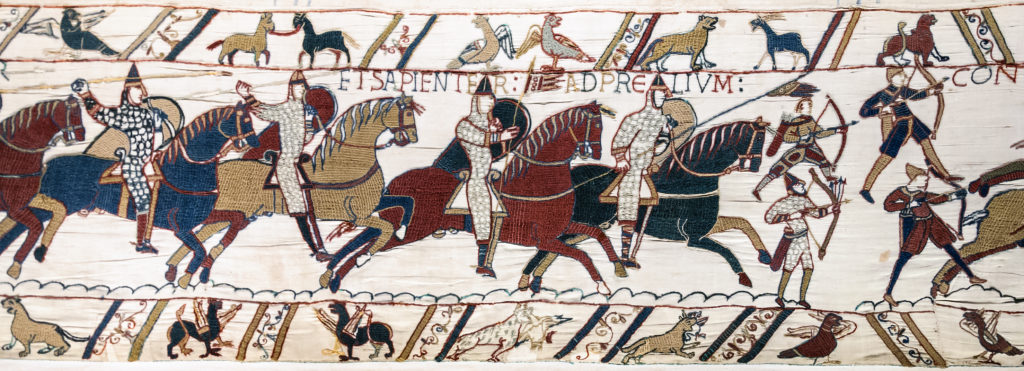
The artistic quality of these illustration makes it impossible to determine whether she shafts are parallel or taper towards the nock. Fletchings are usually over-sized as well, and in the shape of a parallelogram, i.e. cut parallel to the shaft.
Nocks, as a rule, are bulbous, which may indicate that the shafts were indeed tapered, so the nocks had to be widened to accommodate the string groove. But whether they are cut from the shaft material itself or glued on as a separate piece remains subject to speculation.
Viking arrows
From the 9th to the 11th centuries Haithabu, near modern Schleswig in Northern Germany was an important settlement and trade centre where people from many diff erent origins exchanged goods, money, and knowledge.
So archaeological discoveries are not always easy to attribute to specific cultures with absolute certainty. Among the finds from numerous archaeological campaigns there are more than 100 arrowheads, some with remains of the shafts still attached, many of which differ greatly from the contemporary, more southerly designs.
One distinguishing feature is the fact that most of them are equipped with a tang rather than a socket. The dominant forms of arrowheads are leaf or lancet shaped; a number of long, square, socketed iron points (bodkin style) were most likely used in warfare.
Trilobite arrowheads are probably of Eastern origin, having a longstanding tradition and association with mounted archers from the Eurasian steppes.
The comparatively small number of socketed arrowheads of two-bladed or rhombic design resemble the Frankish designs discussed earlier, some bodkin types probably being designed to penetrate chainmail and other body armour.
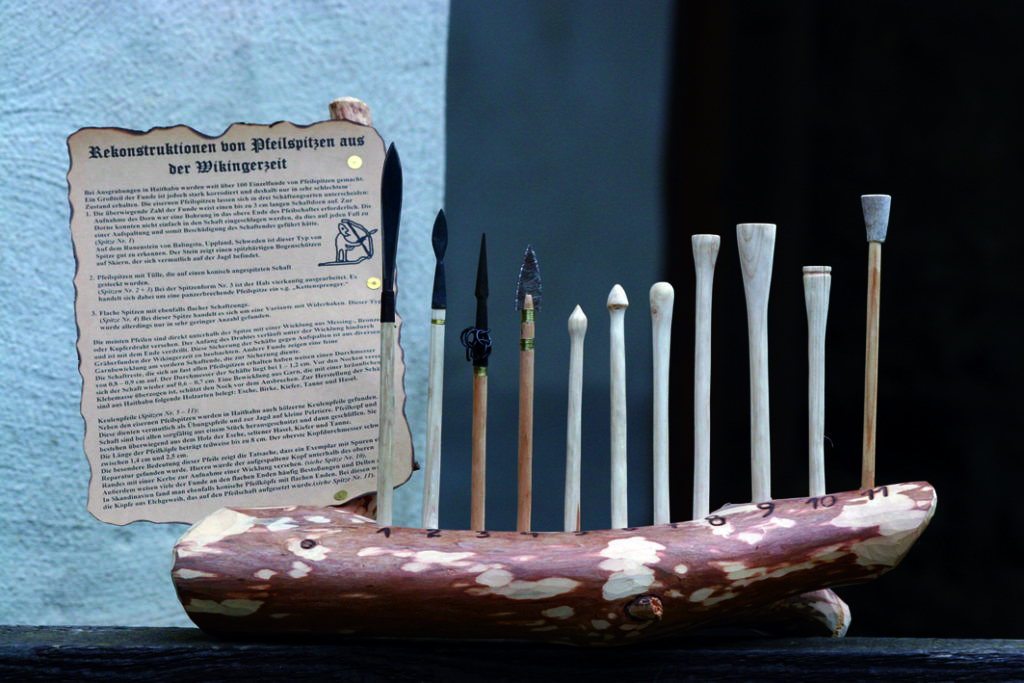
Most unusual is a design of a long, two-bladed leaf-shape with a 90° twist in the middle. Such arrowheads would have cut large wounds with heavy blood-flow and may have been used against foes or animals or both.
The shaft remains were made of birch, some of them equipped with elaborate bronze nocks glued into a conical hole. The diameter was 8–10 mm beneath the heads, tapering to about 6 mm right before the bulbous or glued-on nock.
As had been common practice for centuries, the fl etching area was covered in birch pitch, in which three or four feathers and very narrow whippings have left their marks. Some of the tanged arrowheads were secured by means of very thin bronze or brass wire. The same material may or may not have been used for the fletchings.
Also among the finds were blunt arrows for hunting small game for fur, and birds. They were made from ash wood, rarely from hazel or coniferous woods.
Towards the front the shafts widen to about 2–2.5 cm in diameter with a flat or convex surface. One example was cut to form a pentagon. More arrowheads from the 9th to 12th centuries were found at excavations in Ireland, for example in Waterford, Dublin, or Limerick.
Their shapes are mostly similar to the examples from Haithabu, but the square, socketed bodkin type was the most common design. Due to the context of their discoveries in ’viking’ settlements, all of these arrowheads are often attributed to these Northern warriors and conquerers.
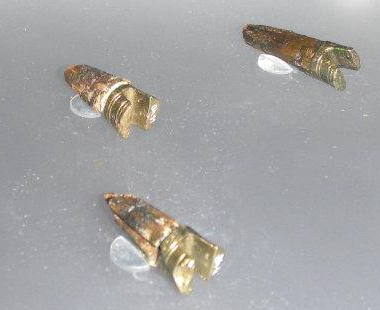
But their use by long-distance sailors is not necessarily an indication for their Scandinavian origin. For example, finds from Birka in Sweden show that even composite bows and thumb-rings have been in use there, which originate from the cultures of the Eurasian steppes.
Archery played a much greater role in Viking society than is generally acknowledged and it stands to reason for them to incorporate the best available material they encountered on their travels and conquests around the world.
Hastings and the Normans
When the viking descendants, the Normans under their duke William invaded and eventually conquered England in 1066 AD, the decisive battle of Hastings was won thanks to a clever new tactical combination of archers and cavalry.
Sadly, on the only pictorial record of this event, the Bayeux Tapestry, the arrows used by the Normans are only depicted very schematically. All of them are equipped with two-bladed triangular arrowheads, which seems unlikely considering the variety of available designs and the apparent popularity and usefulness of the bodkin type.
And unfortunately, no arrowheads have yet been discovered in situ. The Norman archers on the tapestry only pull the strings of their rather short bows to the chest. What could be considered artistic license (so as not to obscure their faces) may actually have a basis in reality, as exemplified by two complete contemporary arrow shafts found in Anglo-Norman contexts in Ireland.

The Waterford arrow is 58 cm (22.8 in.) long, armed with a bodkin point, 9 mm wide beneath the socket, and tapering to a mere 4.5 mm before the nock. The string groove indicates that the arrow is indeed complete and not broken off.
An equally complete arrow shaft from Dublin made of spruce even only measured 53.9 cm (21.2 in.). A leaf-shaped arrowhead was inserted into the front end with a tang.
Both ends were 7 mm in diameter, with a slightly wider centre part. Archaeological contexts and the use of ’serious’ arrowheads make it unlikely for them to have been intended for children.
Despite the limited source material it is evident that early medieval arrows showed a great variety in design, manufacture, and armament. Even within the wider Germanic context, different cultural zones can be distinguished which probably overlapped, and an unknown degree of foreign influences for example from the Eurasian steppes is to be assumed.
While bladed arrowheads remained much in favour for both hunting and warfare throughout the centuries, the marked increase in bodkin type arrowheads can be attributed to the proliferation of chainmail and other protective body armour by the end of the period.
Contemporary artwork does not reflect this variety, and tends towards a very schematic depiction of archers and their equipment, making it impossible to reconstruct early medieval archery from these illustrations alone.


Could you possibly help me with some research ?
I’m looking for specific ” complete arrows of what they looked like ” from mid-evil times from the Norwegians and Germans .
Is there any way you can provide me with the best pictures of what these items might have looked like ?
I would like to create artwork from these images .
Valsgarde burials included lots of complete arrows, so we’ll preserved even painted patterns were visible. I can only post text here, but the write up of the grave finds has some good pictures. If you Google Valsgarde arrows you’ll find some replicas which might be good enough for your needs?
I am just curious if you have ever heard or have knowledge of the use of composite wood shafts used with bodkins for longbow arrows, with apparently a heavier wood used at the pointed end, scarfed onto a lighter wood on the back end? I’m not referring to the practice of using different wood for the nock, but rather the main shaft composition.